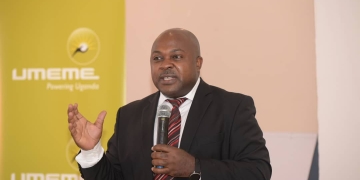
Power distributor Umeme has said it is embarking on an upgrade of all prepaid electricity vending/metering systems to meet the global metering standards and deadline of November 2024.
According to Umeme, the project will be implemented on an area or district-based approach to minimize service interruptions, and that customers shall be informed in time.
“This will improve the customer vending experience, and enhance system security and electricity token recognition,” said Umeme. The rollout strategy is being implemented by Umeme staff and where possible, customer self-service.
“Customers scheduled for the upgrade will receive by SMS, 3 tokens that they should key in the Yaka meter in the order they are received. An upgrade confirmation message shall be displayed once the Token loading is successful.”
Umeme assures that the upgrade project will be completed on time and that it will be a seamless experience. This upgrade aligns with the global transition to the Standard Transfer Specification (STS)2 Token Identifier (TID) standards for prepayment electricity vending and metering systems.
Last week the Ministry of Energy and Mineral Development announced that the current Yaka meters would stop dispensing electricity in November unless upgraded to be compatible with the new vending system.
The Standard Transfer Specification is the global standard for the transfer of electricity and other utility prepayment tokens, ensuring interoperability between system components from different manufacturers. The initiative also promises better efficiency and security of prepayment systems, ensuring that the customers have access to reliable and modern services.
“It will improve the vending experience of customers and enhance the security of Yaka tokens during and after purchase.” The Token Identifier (TID) is a 24-bit field, contained in the compliant tokens, that identifies the date and time of the token generation, in the current system, since 1993. It is used to determine if a token has already been used in a payment meter.
The TID represents the number of minutes elapsed since the base date of 1st January 1993. “The incrementing of the 24-bit field means that at some point in time, the TID value will roll over to a zero value,” according to the STS Association.
Energy Minister Ruth Nankabirwa told journalists at the Uganda Media Centre on Friday that prepaid electricity users will have to migrate to the new Token Identification System, known as the TID Rollover by October 2024.
The new meters will mean a change from the existing Token Identifiers (TID). In South Africa, the operators announced that token Identifiers will run out in November 2024.
Nankabirwa said that the standard of metering is being recognized at the global level because, with it, a consumer can use it to switch electricity payments from one utility provider to another.
“We have set for ourselves a target to have all Uganda’s Electricity Consumer’s Yaka (prepaid) meters migrated onto the New Token Identification System by October 2024 to be able to continue purchasing Units for their Electricity Supply seamlessly,” the minister said.
“This change is happening on a global scale and will affect all consumers on the Prepayment Metering system,” she added.
The government recently mooted a plan to have electricity tokens by different operators other than the current Yaka system offered by Umeme Uganda Limited.
Uganda is undertaking several reforms in its power sector supported by the Electricity (Amendment) Act, 2022. The amendment, which seeks to end monopoly in the power sector, has already led to the pending exit of UMEME.
“All efforts are being made to support UEDCL to get ready to take over the operations of the Umeme network come 1/4/25. UEDCL has been given the financial and technical support required to seamlessly receive and operate the network without any consternation,” Nankabirwa explained.
“Specifically, for the UMEME exit, we set up a Joint Technical Committee (JTC) to supervise and manage the transition process,” she added.
The Energy Policy for Uganda 2023 aims to achieve the Electricity generation capacity target of 52,481MW by 2040 with a grid access rate of 80%. To achieve this ambition, the minister said the government will need to address the sub-sector holistically, not piecemeal.











Discussion about this post